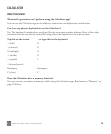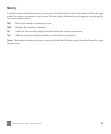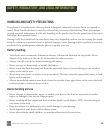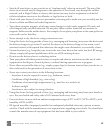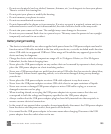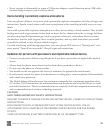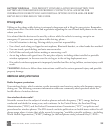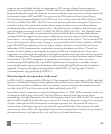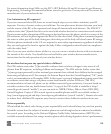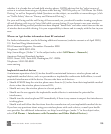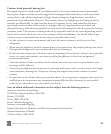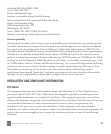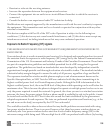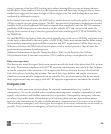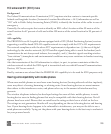
ONEm User Guide - R1.0.2 - October 20, 2010 103
shows no increased health risk due to radiofrequency (RF) energy, a form of electromagnetic
radiation that is emitted by cell phones.” The FDA also cites a separate National Cancer Institute
program finding that, despite the dramatic increase in cell phone use, occurrences of brain cancer did
not increase between 1987 and 2005. You can access the FDA website at http://www. fda.gov/
ForConsumers/ConsumerUpdates/ ucm212273. htm. You can also contact the FDA toll-free at (888)
463-6332 or (888) INFO-FDA. The FCC has its own website publication stating that “[t]here is no
scientific evidence that proves that wireless phone usage can lead to cancer or other problems,
including headaches, dizziness or memory loss.” This publication is available at http://www.fcc. gov/
cgb/cellular.html or through the FCC at (888) 225-5322 or (888) CALL-FCC. The National Cancer
Institute (“NCI”) states that concerns about the potential health effects of using cellular phones—
“and specifically the suggestion that using a cell phone may increase a person’s risk of developing
brain cancer— are not supported by a growing body of research on the subject.” You can access NCI’s
review of the research at http://www.cancer.gov/ ncicancerbulletin/NCI_Cancer_Bulletin_092308/
page7. The WHO’s Interphone study is the largest study of cell phone use and brain tumors ever
undertaken. WHO summarized its conclusions concerning Interphone as follows: “Overall, no
increase in risk of glioma or meningioma was observed with use of mobile phones. There were
suggestions of an increased risk of glioma at the highest exposure levels, but biases and error prevent
a causal interpretation. The possible effects of long-term heavy use of mobile phones require further
investigation.” The WHO’s comments on Interphone are available at: http://www.iarc.fr/en/
mediacentre/pr/2010/pdfs/pr200_E.pdf. WHO’s publication of Interphone is available at http://
www.oxfordjournals.org/our_journals/ije/press_releases/freepdf/dyq079.pdf; see also, Interphone
Appendix 1 (http://ije.oxfordjournals.org/cgi/data/ dyq079/DC1/1), and Appendix 2 (http://
ije.oxfordjournals. org/cgi/data/dyq079/DC1 /2).
What does Specific Absorption Rate (SAR) mean?
In 1996, the FCC, working with the FDA, the U.S. Environmental Protection Agency (EPA) and other
agencies, established RF exposure safety guidelines for wireless devices in the United States. Before a
wireless device model is available for sale to the public, it must be tested by the manufacturer and
certified to the FCC that it does not exceed limits established by the FCC.
One of these limits is expressed as a Specific Absorption Rate, or “SAR.” SAR is a measure of the rate
of absorption of RF energy in the body. Tests for SAR are conducted with the wireless device
transmitting at its highest power level in all tested frequency bands. Since 1996, the FCC has required
that the SAR of handheld wireless devices not exceed 1.6 watts per kilogram, averaged over one gram
of tissue. Although the SAR is determined at the highest power level, the actual SAR value of a
wireless device while operating can be less than the reported SAR value. This is because the SAR
value may vary from call to call, depending on factors such as proximity to a cell site, the proximity of
the wireless device to the body while in use, and the use of hands-free devices.




